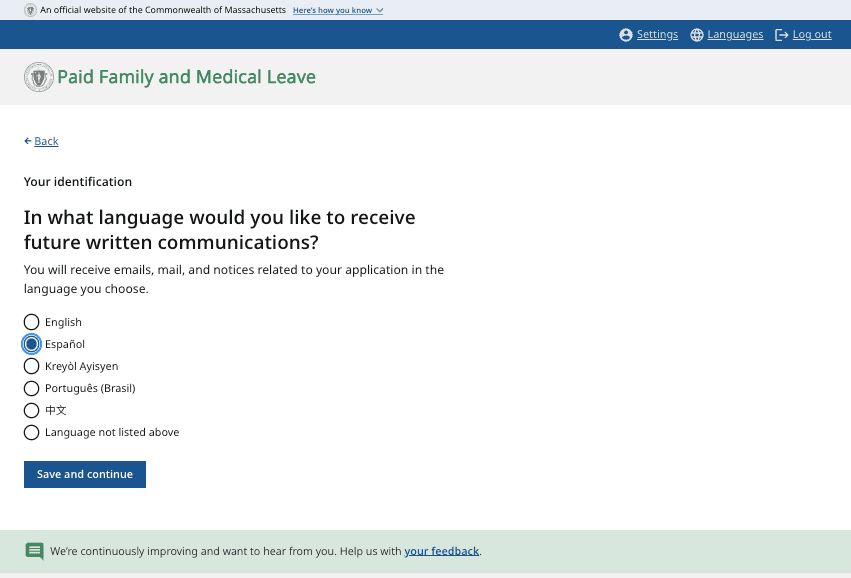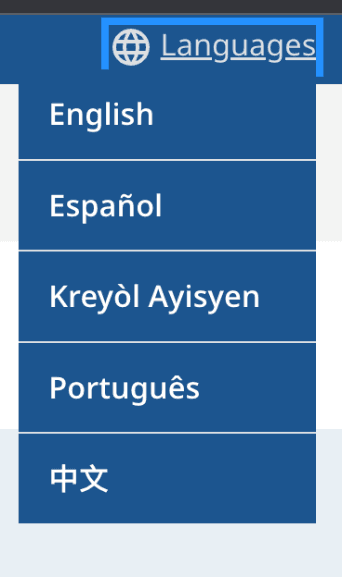Receiving paid family and medical leave (PFML) benefits can alleviate financial burden for workers who must take time off for major life events, such as caring for a sick loved one or bonding with a new child. But for people whose primary language is not English, applying for public benefits like PFML can seem daunting. The Commonwealth of Massachusetts recognized this as a major barrier to accessing PFML benefits and has taken steps to make their online application experience available in five languages. Under our longstanding software development contract with Massachusetts, Nava helped implement the technology that enables people to make a language selection for receiving emails and official state notices. We also helped improve the experience of selecting a language to navigate the application website.
Approach
Our work was informed by U.S. Web Design System (USWDS) best practices, existing system constraints, and the need to deliver quickly. In order to help Massachusetts provide an excellent user experience within the allotted time, we broke our work into two buckets, applied a content-first approach to design, and collaborated early and often with design and engineering as well as with Massachusetts and other vendor partners.
Outcomes
This work makes PFML much more accessible and equitable by serving a subset of people who may have found it difficult to navigate the program in English. As of Jan. 2024, about 2-3 percent of people per day are choosing to receive official notices and navigating the application website in a language other than English.
By centering on USWDS best practices, Nava helped implement enhancements for language selection for state notices and on the application website. This means that emails and notices from the state do not default to any language, but that people can select their language preference each time they apply for benefits. It also means ensuring that people can change their language for navigating the website at any point, and that doing so is simple and straightforward.
With Massachusetts’ Department of Family and Medical Leave (DFML), Nava delivered the front-end PFML application experience in under four months. DFML and other vendors implemented the initial approach for selecting a language on the application website and made updates to the application programming interface (API), the back-end system, and the email notification system.
Process
When we began, Massachusetts had already done work to set this software development effort up for success. For example, they already knew that the most common languages spoken in Massachusetts besides English are Spanish, Chinese, Portuguese, and Haitian Creole. Additionally, Massachusetts worked with another vendor to implement a feature that allowed people to toggle between languages on the application website. The key opportunity coming out of this initial language selection work was to improve the user experience on smaller screens as well as increase accessibility.
Enabling people to choose a language preference for emails and official state notices
When someone has a new notice available, they either receive it in the mail or get an email telling them the notice is available on the application website. Our shared goal for this piece of work was to communicate to people in plain language that there was a new notice on their account, and to then make these notices available in their chosen language and in English. DFML wanted to make the notices available in both languages because other people such as employers, call center and DFML staff, family members, or community agency staff may review these notices and prefer to read them in English. Therefore, we had to communicate to applicants that their notice would first appear in their chosen language, and then would be repeated in English. We did this to reduce potential confusion for people with limited English proficiency.
We worked with Massachusetts to craft plain language messages to explain all of this to applicants and to employers. Together, we decided to rename official state communications “written notices” rather than “legal notices” so as not to alarm or confuse people.

A screenshot of the question that asks people in what language they’d like to receive written communications.
People can choose their language preferences for notices when filling out their PFML application. During the process, claimants are prompted to choose what language they’d like to receive future written communications in. Claimants can choose from the five supported languages and an option for language not listed. If an applicant chooses language not listed, they’re met with a message explaining that their communications will be in English and directing them to translation services. This promotes inclusivity for people whose primary language isn’t represented, and prevents claimants from getting stuck on this question because their language isn’t listed.
Optimizing how people choose their language preference for the PFML application website
To promote usability and accessibility of the application website, we moved the language selection tool from the initial location to the top right header. This is a common location for finding information or a login/logout button. We also labeled the feature with a universal language icon and listed language options in that language instead of in English. For example, we listed Haitian Creole as Kreyòl Ayisyen.

A screenshot of how people can select a language on the application website.
We accompanied this with a plain language message on the application website homepage that explains how to change the language. This message is translated into each of the supported languages, so that people are immediately met with a message they can understand.

A screenshot with the message that people see when they enter the PFML application website.
People can change their language preference at any time by selecting the Languages icon in the header, which allows multiple people with different language needs to fill out the same application. An applicant might be working with a caseworker at a community organization to fill out their application, and that caseworker might prefer to use the website in another language. We also wanted to make sure that people could change their language preferences even if they’re not logged into the application website, allowing people to get started even without having an account.
To implement this work, Nava’s designers and engineers collaborated early and often. Designers and engineers would participate in live coding sessions where designers would propose changes and engineers would mock them up on the spot. Working in parallel allowed us to be more efficient and was a big reason we were able to deliver this work so quickly.
Collaborating to work smarter and faster
While designing this feature, we used a content-first design approach where we developed the designs and content strategy in parallel with the user interface and user experience (UI/UX) aspects. Content-first methodology helped us hone our designs faster, which enabled us to involve engineers at an earlier stage.
While design honed the content of the website’s front-end, our engineers wanted to make sure that data people entered into the application successfully made it to the back-end through our API. In the typical software development lifecycle, engineers would wait until the front-end design is complete and then would create a mock application and submit it through the website. But in the interest of launching by our target date, we wanted to ensure our API functioned properly while honing the front-end. Our engineers created a workaround solution using Postman, an API platform for building and using APIs. We used Postman to send data that we’d expect the front-end to send, and then looked at the back-end to see if that data was properly transferred. By working in parallel, our engineers and designers were able to deliver outcomes quickly and efficiently. In fact, our engineers delivered their work two weeks early.
Conclusion
By implementing USWDS best practices and collaborating across teams, we were able to help Massachusetts enhance the experience of applying for PFML benefits. Enabling people to choose their language preference for the application website and for state notices expands the accessibility and impact of Massachusetts’ PFML program while promoting trust in government.
Special thanks to Jennifer Kalashian who contributed to this article.
Written by

Senior Editorial manager

Product manager

Design lead
